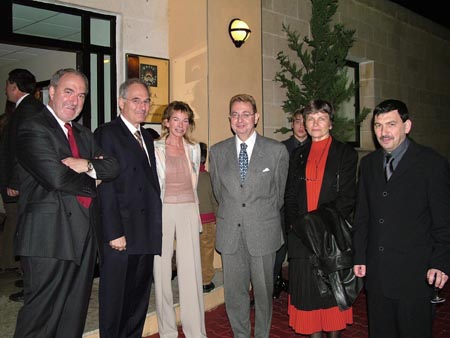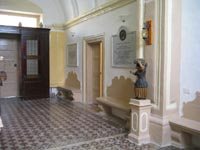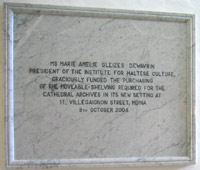Maltanedienol
A new molecule “Maltanedienol” was officially named in honour of Malta. As far as we know, not since Sir David Bruce’s discovery of a micro-organism connected to undulant fever in 1887 and named Brucellosis Melitensis, has a scientific discovery been named with Malta in mind
“Maltanedienol” was discovered by a team of Maltese, French and Tunisian scientists working together on the unique healing properties of Mediterranean seaweed.
The official naming ceremony took place at the Institute of Cellular Pharmacology in Mosta’s Technopark and was attended by the President of Malta, Professor Guido de Marco, George Pullicino, Minister for Rural and Environmental Affairs, the French ambassador, Patrick Chrismant and other personalities.

After slide presentations by Mr Saliba and Dr Gutierrez, Professor Mark Brincat who is also involved in this research project, said this was just the beginning of a dream. He praised Dr Gutierrez, who, he said, had a superb knowledge of Pharmacology and Molecular biology as well as faith in Malta since he continued to stick to the belief that good work can be done here.
Also present at the naming ceremony was Marie-Amélie Gleizes Dewavrin, president of the Institute for Maltese Culture, which is helping and supporting this research project especially by facilitating contacts.
“If Malta wants to retain its identity, one way of doing it is through shared scientific research. We have some brilliant young scientists locally, but we must continue to stimulate the grass roots if we want to have plenty of scientific research going on here,” Mr Saliba and Dr Gutierrez agreed.
Abstracted from Marie Benoit – The Malta Independent Online – 22 February 2004
OPERA TO COMMEMORATE MALTA'S ENTRY IN THE EU
musique de Charles Camilleri
livret de Peter Serracino Inglott

Discour De La Presidente Marie Amélie Gleizes Dewavrin:
Je voudrai tout d’abord vous dire quelques mots sur l’institut pour la culture maltaise que je représente et qui a l’honneur de produire ce soir
«The Maltese Cross »
Il y a quelques années, lors de mon arrivée dans cette ravissante petite île de Malte j’ai été fasciné par la qualité et la richesse de la culture maltaise.
En effet j’ai tout simplement trouvé a Malte une culture dont les manifestations ,du néolithique à nos jours, sont d’une qualité impressionnante .En un mot en tant qu’européenne j’y ai trouvé mes racines.
J’ai donc pensé qu’il était important de participer à faire connaître la culture maltaise et c’est là l’objectif de l’Institut.
Pour terminer, je voudrais adresser à son Excellence Monsieur l’Ambassadeur de malte, tous mes remerciements pour le rôle essentiel qu’il a , en tant que Directeur des Programmes de l’Institut, dans le choix et la réalisation de tous nos projets.
Discour de l’ Organisateur de l’Opéra – Salvino Busuttil – Ambassadeur de Malte en France
Durant les dernières vingt années de sa vie, Schiller avait beaucoup de mal à compléter la tragédie ‘à la grecque’ avec le Grand-Maître La Valette pour héros et le Grand Siège de Malte par Souleyman le Magnifique en 1565 comme contexte.
Leur idée n’est pas de compléter l’œuvre de Schiller, ainsi que l’on fait au moins trois autres auteurs après sa mort. Au contraire, ils questionnent le paradoxe de Schiller de sa fascination pour le thème du “dernier des croisées” et la frustration continue de son désir ardent de voir l’expression dramatique complétée”: sa “Croix de Malte”.
La Croix de Malte est une célébration de l’âme européenne, enracinée dans ces valeurs, qui, pour des millénaires représentaient l’Europe comme le dernier rempart. Mais l’esprit de la Croix de Malte est celle de l’esprit de Malte d’aujourd’hui – pas d’exclusion, mais d’ouverture envers ses partenaires européens et au-delà, où même les ennemis d’antan peuvent venir en amis vers ce petit pays, symbolisant la solidarité à l’égard de l’humanité. Plutôt qu’étant « lourde », aujourd’hui la Croix de Malte est l’annonciateur de l’espoir pour une paix durable en Europe et en Méditerranée.
THE IMC SPONSORED THE TRANSFER OF THE MUSICAL ARCHIVES OF THE MDINA EPISCOPAL CURIA
The Mdina Cathedral Archives have been transferred to 11, Villegaignon Street, Mdina.
The new archives carry the records of the Mdina Episcopal Curia, the Musical Archives and other collections which had previously been housed in the ground floor of the Cathedral Museum since it opened in 1969.
Throughout the past 35 years, scholars availed themselves of the archives and enriched Malta’s history with the fruitful results of their research, the Curia said.
It said that in order to further promote this achievement and to provide more space for the museum’s prestigious collections, it was deemed opportune to provide more space for the archives.


Agatha Formosa Gauci donated to the Cathedral Chapter a house at Mdina to serve as an alternative setting for the archives while enhancing the memory of her uncle – the late Archdeacon Mgr Joseph Apap Bologna.
Maltese Culture Institute president Marie Amelie Gleisez Dewavrin made a generous financial donation towards the purchase of moveable scaffolding needed to systemise the archives in the available space of their new setting.
The new premises were inaugurated yesterday with a Mass led by the Archbishop, Mgr Joseph Mercieca at the cathedral.
The Mass also marked the 302nd anniversary of the cathedral’s consecration. It was followed by an organ recital by cathedral organist John Aquilina who played pieces from Vivaldi, Bach, Vierne and Boellmann
Abstracted from the Malta Times 09 October 2004